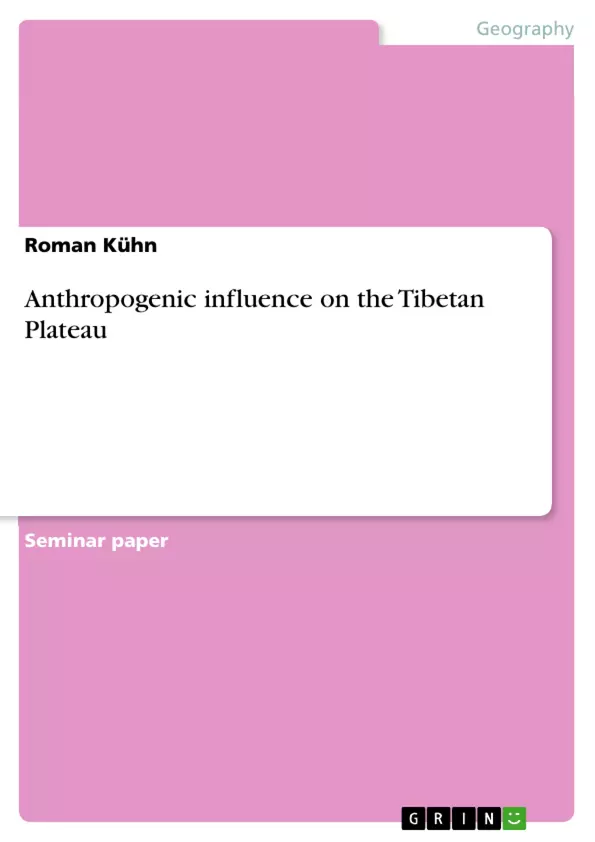The Tibetan Plateau is probably the most important and one of the most fragile areas in the world. With its enormous tectonic geomorphology forms and its unique ecosystem the Tibetan Plateau has an huge impact on the asian continent and even on the whole global climate (Cui/Graf 2009:49). For hundred of years this area was inhabited by few nomads, who practiced a sustainable approach of life in this space. Initiating with the reforms of " the Great Leap Forward, the Opening Door Policy and the Globalisation" an imigration flow began to discover and settle down. Those hu-man activities had an influence on the climate change and land-cover change. The consequences resulting thereoff are evident and measurable and the aftereffects of that development cant yet be foreseen in their whole scale.
The purpose of this study is to examinethe anthropogenic influence on the Tibetan Plateau in recent years. The structure applied to this paper begins with a geographic classification of the Tibetan Plateau with its geographical, geomorphological and climatical charecteristics. The second part discribes the anthropogenic influence on the Plateau area and its demographical and agricltural development since the 1950s. The impacts of this influence on the vegetational and soil change are being discribed in the third part and the conclusion finalises this study.
Inhaltsverzeichnis (Table of Contents)
- Introduction
- Geographic Classification of the Tibetan Plateau
- Traditional Nomad pastoralism on the Tibetan Plateau.
- Soil degradation..
- Deforestation.........
- Soil erosion
- Desertification......
- Conclusion........
- References..
Zielsetzung und Themenschwerpunkte (Objectives and Key Themes)
This study aims to examine the anthropogenic influence on the Tibetan Plateau in recent years. The paper begins with a geographic classification of the Tibetan Plateau, including its geographical, geomorphological, and climatical characteristics. It then discusses the anthropogenic influence on the Plateau area and its demographical and agricultural development since the 1950s. The impacts of this influence on the vegetational and soil change are described, and the conclusion finalizes the study.
- The impact of human activities on the Tibetan Plateau's environment and climate.
- The historical and contemporary development of land use and land cover change.
- The influence of traditional nomadic pastoralism and its transformation.
- The consequences of soil degradation, including deforestation, soil erosion, and desertification.
- The role of the Tibetan Plateau in global climate change and regional atmospheric circulation.
Zusammenfassung der Kapitel (Chapter Summaries)
The introduction presents the Tibetan Plateau as a crucial and fragile area with a significant impact on the Asian continent and global climate. It highlights the impact of human activities, particularly migration and development, on the environment. Chapter 2 provides a comprehensive geographic classification of the Tibetan Plateau, outlining its unique geomorphological and climatological features, including its position as the "Roof of the World" and its contribution to global atmospheric circulation. Chapter 3 focuses on traditional nomadic pastoralism as the dominant form of land use on the Tibetan Plateau, highlighting its long history and the sustainable approach of Tibetan nomads. The chapter explores how the nomadic culture has transformed the natural grazing system and the impact of grazing intensity on vegetation composition and structure. The discussion then shifts towards the influence of the Chinese economic growth on traditional pastoral practices, examining the effects of increased livestock numbers and the pressure on the fragile ecosystem.
Schlüsselwörter (Keywords)
The primary keywords and focus topics of the text are: Tibetan Plateau, anthropogenic influence, climate change, land use change, traditional nomadic pastoralism, soil degradation, deforestation, soil erosion, desertification, ecological equilibrium, global atmospheric circulation, Asian continent, sustainable development, economic growth, and the Great Leap Forward.
- Quote paper
- Roman Kühn (Author), 2014, Anthropogenic influence on the Tibetan Plateau, Munich, GRIN Verlag, https://www.hausarbeiten.de/document/279211


